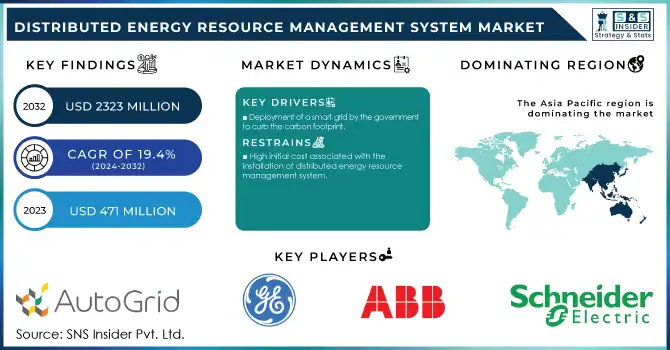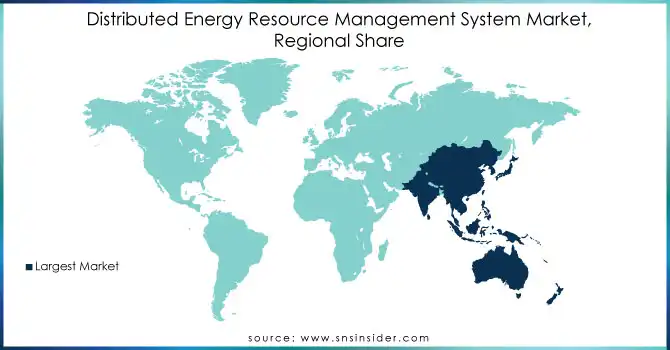Distributed Energy Resource Management System Market Report Scope & Overview:

Get More Information on Distributed Energy Resource Management System Market - Request Sample Report
The Distributed Energy Resource Management System Market size was valued at USD 471 million in 2023 and is expected to grow to USD 2323 million by 2032 and grow at a CAGR of 19.4% over the forecast period of 2024-2032.
The Distributed Energy Resource Management System (DERMS) is a cutting-edge technology that enables the efficient management of energy resources. This system is designed to optimize the use of distributed energy resources, such as solar panels, wind turbines, and energy storage systems, to ensure that energy is generated and consumed in the most cost-effective and efficient manner possible.
It is a powerful software platform designed to streamline the operation of aggregated DERs within a power grid. Typically, DERMS applications are utilized at the distribution grid level. However, to fully integrate DERMS with a utility, a distribution management system (DSM) is required. By utilizing DERMS, utilities can more effectively manage their distributed energy resources, resulting in a more efficient and reliable power grid.
DERMS is a sophisticated platform that integrates various energy resources and provides real-time monitoring and control of energy generation and consumption. It enables utilities and energy providers to manage their energy resources more effectively, reduce energy waste, and improve the reliability and resilience of their energy systems. DERMS is a powerful tool that enables the efficient management of distributed energy resources.
With DERMS, energy providers can better manage the variability and unpredictability of renewable energy sources, such as solar and wind power. This technology allows them to balance the supply and demand of energy in real time, ensuring that energy is available when and where it is needed most.
Market Dynamics
Drivers
-
Increasing demand for renewable energy resources
-
Deployment of a smart grid by the government to curb the carbon footprint
-
Increasing installation of rooftop solar panel
To reduce the carbon footprint, the demand for renewable energy resources has increased. This has led to a surge in the adoption of technologies that enable the efficient management of distributed energy resources. In addition, governments around the world are taking steps to reduce their carbon emissions by deploying smart grids. These grids are designed to optimize the distribution of energy, reduce waste, and increase efficiency. All of these factors have contributed to the growth of the DERMS market, which is expected to continue expanding in the coming years.
Restrain
-
High initial cost associated with the installation of distributed energy resource management system
Opportunities
-
Continuous investment in the digitalized grid infrastructure
Challenges
-
Risk associated with the cybercrime
The DERMS market has been impacted by cybersecurity risks. As technology continues to advance, the threat of cyber-attacks becomes more prevalent, and companies must take proactive measures to protect their assets. The impact of cybercrime on the DERMS market highlights the importance of investing in robust cybersecurity measures to safeguard against potential threats.
Impact of COVID-19:
The unexpected global crisis of COVID-19 affected the Distributed Energy Resource Management System (DERMS) market. The pandemic has caused disruptions in the supply chain, leading to delays in the production and delivery of DERMS components. This has resulted in a slowdown in the growth of the DERMS market. Additionally, the pandemic has caused a decrease in demand for energy due to the closure of businesses and reduced economic activity, further impacting the DERMS market. However, the pandemic has also highlighted the importance of DERMS in ensuring a resilient and sustainable energy system. As countries look to recover from the pandemic, there is a growing focus on investing in renewable energy and DERMS to reduce dependence on fossil fuels and increase energy security.
Impact of the Russia-Ukraine War:
The Russia and Ukraine war impacted various industries, including the Distributed Energy Resource Management System (DERMS) market. The war has disrupted the energy supply chain in Ukraine, which has led to an increased demand for DERMS. The country has been forced to rely on its own energy resources, including renewable energy, to meet its energy needs. This has created a significant opportunity for DERMS providers to expand their market share in Ukraine. However, the conflict has also had a negative impact on the DERMS market in Russia. The country has been hit with economic sanctions, which have limited its ability to invest in renewable energy. This has resulted in a decrease in demand for DERMS in Russia.
Impact of Recession:
The Distributed Energy Resource Management System (DERMS) market has been significantly impacted by the recent recession. This has resulted in a decrease in demand for DERMS products and services, as well as a decrease in investment in the industry. The recession has caused many businesses to cut back on their spending, including their investment in renewable energy technologies. This has led to a decrease in demand for DERMS products and services, as businesses are less likely to invest in new energy management systems during times of economic uncertainty. Furthermore, the recession has also impacted the availability of funding for DERMS projects. Many investors are hesitant to invest in new projects during times of economic uncertainty, which has made it more difficult for companies in the DERMS industry to secure the necessary funding to develop new products and services.
Key Market segmentation
By Software
-
Management and Control
-
Analytics
-
Virtual Power Plants
By End-user
-
Commercial
-
Residential
-
Industrial & Utilities
By Application
-
Energy Storage
-
Wind
-
Solar PV
-
Combined Heat and Power
-
EV Charging
Regional Analysis
By region, the Asia Pacific region dominated the Distributed Energy Resource Management System market. This is due to the significant investments made by government bodies in renewable energy projects, as well as the increasing power generation activities in the region. As a result, the Asia Pacific region is poised to capture the largest market share in this sector.
Another factor that drives the growth of the DERMS market is the rapid expansion of solar and wind renewable energy installations, as well as the excessive energy demand. In response to this demand, Horizon Power launched a new DERMS in Western Australia's regional microgrids in August 2022. This innovative system will allow consumers of rooftop solar, batteries, and electric vehicles to safely connect with utility energy supplies, representing a significant advancement in the field.
North America is also expected to show lucrative growth during the forecast period. The U.S. is the major country that contributed major to this growth. North America is poised to make a significant impact on the global renewable energy market. This is due to the increasing investments made by governments in renewable projects, as well as the commitment of various countries to achieve net zero emissions by 2050. As a result, North America is expected to hold a substantial market share in the renewable energy sector which further drives the growth of the DERMS market.
Europe is also anticipated to show significant growth owing to the presence of a large number of projects related to DERMS-based software in the renewable energy system.

Need any customization research on Distributed Energy Resource Management System Market - Enquiry Now
REGIONAL COVERAGE:
-
North America
-
USA
-
Canada
-
Mexico
-
-
Europe
-
Germany
-
UK
-
France
-
Italy
-
Spain
-
The Netherlands
-
Rest of Europe
-
-
Asia-Pacific
-
Japan
-
south Korea
-
China
-
India
-
Australia
-
Rest of Asia-Pacific
-
-
The Middle East & Africa
-
Israel
-
UAE
-
South Africa
-
Rest of the Middle East & Africa
-
-
Latin America
-
Brazil
-
Argentina
-
Rest of Latin America
-
Key Players
The major players are Autogrid Systems, Inc., General Electric, ABB Ltd, Siemens AG, Schneider Electric, Spirae, Inc., Enernoc, Inc., Open Access Technology International, Inc., Enbala Power Networks INC., Doosan Gridtech, Inc. (Doosan Heavy Industries & Construction), and Blue Pillar, Inc., and other key players will be included in the final report.
| Report Attributes | Details |
| Market Size in 2023 | US$ 471 Mn |
| Market Size by 2032 | US$ 2323 Mn |
| CAGR | CAGR of 19.4% From 2024 to 2032 |
| Base Year | 2023 |
| Forecast Period | 2024-2032 |
| Historical Data | 2020-2022 |
| Report Scope & Coverage | Market Size, Segments Analysis, Competitive Landscape, Regional Analysis, DROC & SWOT Analysis, Forecast Outlook |
| Key Segments | • By Software (Management and Control, Analytics, Virtual Power Plants) • By End-user (Commercial, Residential, Industrial & Utilities) • By Application (Energy Storage, Wind, Solar PV, Combined Heat and Power, EV Charging) |
| Regional Analysis/Coverage | North America (USA, Canada, Mexico), Europe (Germany, UK, France, Italy, Spain, Netherlands, Rest of Europe), Asia-Pacific (Japan, South Korea, China, India, Australia, Rest of Asia-Pacific), The Middle East & Africa (Israel, UAE, South Africa, Rest of Middle East & Africa), Latin America (Brazil, Argentina, Rest of Latin America) |
| Company Profiles | Autogrid Systems, Inc., General Electric, ABB Ltd, Siemens AG, Schneider Electric, Spirae, Inc., Enernoc, Inc., Open Access Technology International, Inc., Enbala Power Networks INC., Doosan Gridtech, Inc. (Doosan Heavy Industries & Construction), and Blue Pillar, Inc. |
| Key Drivers | • Increasing demand for renewable energy resources • Deployment of a smart grid by the government to curb the carbon footprint |
| Market Opportunities | • Continuous investment in the digitalized grid infrastructure |

